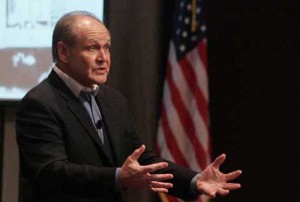
Then Chrysler Chairman and CEO Bob Nardelli explains details of the company's viability and accountability plan with senior management.
With the new Chrysler Group LLC on the road, the company’s old chairman and chief executive is officially out of job. He said he was heading back to wait in the bullpen at Cerberus Capital Management for another call. It might be a long wait, since Cerberus’ appetite for risk has probably diminished since taking on Chrysler. In fact some observers question whether private equity firms will ever be as prominent as they once were before the financial meltdown.
However, to judge Nardelli fairly, you have to separate what he did in Auburn Hills from the speculative failure of Cerberus, which ultimately saw it donating its share of Chrysler LLC to the government to escape what was a bad, leveraged bet.
Considering the challenges he faced, Nardelli actually did a pretty good job.
In fact, Nardelli’s tenure was marked by an enormous amount of stress right from the start as Daimler AG cut its ties and fled back to Germany where the competition was far less intense and the government far more supportive and protective of companies in the industrial sector.
Moreover, not only had Daimler’s European executives failed at turning around the company’s fading fortunes, but so had the American management team that had tried to run the company immediately after 1998’s merger with the German automaker.
In addition, Nardelli arrived in Detroit fresh from the controversy surrounding his huge compensation package, totaling roughly $215 million, when he walked out of Home Depot’s Atlanta headquarters.
Nardelli, however, understood from the start at Chrysler he was on a sort of probation and despite arriving at time of maximum stress for both the company and the economy, he appears to have set Chrysler on a more sustainable path, which is more than you can say for most of his predecessors like Dieter Zetsche.
For example, he emphasized the need to get ahead of the competition in this critical area of fuel economy. “There is no going back,” he told reporters earlier this year.
Certainly, the sharp rise in gasoline prices and Cerberus’ decision to recruit former Toyota executive Jim Press as vice chairman helped put the company on a new course.
However, as gasoline prices start to rise this summer, Chrysler is in a stronger position on fuel economy than it was two years ago or before it was even forced to contemplate bankruptcy.
Nardelli also promised he wasn’t going to dither. During his short tenure, he was consistently ahead of the pack at recognizing changes with industry trends and reacting to shifts in the market.
The decision last year to eliminate 10,000 salaried jobs just before Thanksgiving was enormously difficult and opened him up to second guessing. It was painful for Chrysler employees – both those who left and those who stayed.
With the help of some well-timed federal loans, Nardelli managed to keep the company intact during a long and difficult winter. The company, despite some long odds, is still around. It expects to start building cars again soon and has new models ready to roll into showrooms next fall. Its short term fate is heavily dependent on an economic recovery that has yet to reappear.
Nardelli also had pushed Chrysler into building electric vehicles, which probably provided the wee bit of light President Barack Obama’s Auto Task Force needed to recommend more loans for Chrysler when everybody else was telling people to let it sink.
Ultimately, he also lined up the deal with Fiat that provided Chrysler a new lease on life. That should count as a save. It’s up to the new team to produce a win.
It probably helped that Nardelli really wasn’t in it for the money. What he really wanted was to restore his reputation as an executive and as a leader. Luck ran against him because of the global Great Recession.
But he did succeed in injecting an outsider’s much-need perspective into Chrysler at a most critical time in its history.
